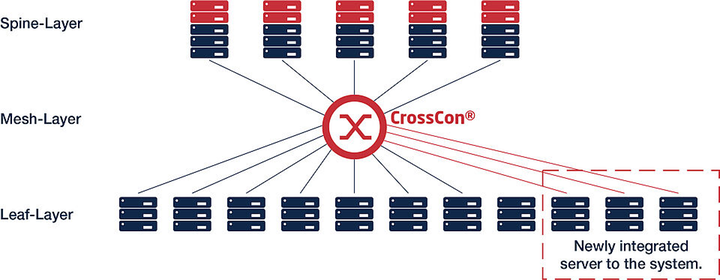Rosenberger OSI collaborates with FiberCon to develop new MTP/MPO system
Fiber-optic experts bundle competencies to develop an MTP/MPO version of the FiberCon CrossCon system.
“With our joint product, we are focusing on an internationally standardized connection system based on MTP/MPO, which will revolutionize data center operations in the future,” says Rosenberger OSI’s Managing Director, Thomas Schmidt.
Rosenberger Optical Solutions & Infrastructure (Rosenberger OSI) announced on Jan. 21 that it has signed an extensive cooperation agreement with FiberCon GmbH, a specialist in the field of optical data transmission with more than 20 years of experience in research and development of new connection technologies. Both companies seek to benefit from their joint know-how in fiber optics and interconnect technology to further optimize data center operations. The goal of the new agreement is joint development of an MTP/MPO version of FiberCon’s CrossCon system.
“With FiberCon we have found a perfect partner for innovative data center infrastructure solutions,” commented Thomas Schmidt, managing director of Rosenberger OSI. “With more than 25 years of in-depth experience as a pan-European assembler of innovative solutions for data centers, local networks, telecommunication and industry, we are very pleased to be able to combine our know-how with another cabling specialist.”
One of FiberCon’s proprietary innovations is its patented CrossCon system for structured data center infrastructures. An integrated 19″ rack unit, the CrossCon system is designed to ensure standardized, structured and yet flexible data center cabling at all times.
Thanks to a new type of plug-in scheme, the system enables any connected rack terminal to communicate with any other rack terminal of the entire cross-connection scheme in the data center. The CrossCon connection core displays its full potential in terms of scalability, especially in modern data center topologies such as the fully crossed Spine-Leaf architecture.
As explained by the companies: “The fully meshed Spine-Leaf architecture is increasingly used in modern and powerful data center infrastructures. In this scheme, each router or switch in the upper layer is connected to all routers, switches or servers in the lower layer, resulting in very low latency, high reliability and easy scalability. The disadvantages of the new architecture, however, are the increased space requirements and the massive operational effort that results from the high number of physical connections and complex cross-connection topologies. This is where CrossCon comes in.”
The companies add, “In contrast to the classic structure of a Spine-Leaf architecture, there is no need for complex cabling here, since the signals are crossed within the CrossCons and are only routed to and from the CrossCon with patch or trunk cables. This new type of signal routing can drastically improve the documentation of the cable routing and reduce the number of necessary plugging operations. Complex work processes during the initial installation and the subsequent extension of further routers are thus avoided and a statistical source of error is reduced.”
The aim of the companies’ collaboration is future joint development of an MTP/MPO version of the CrossCon system. The companies state that “the advantages of the MTP/MPO connector are obvious [for the following reasons]: MTP/MPO is an internationally standardized connector system and therefore manufacturer-independent, which is advantageous for future extensions and system reconfigurations. In addition, MTP/MPO connectors can accommodate 12 or 24 fibers, resulting in considerable space savings on the PCB and in the rack.”
“With our joint product, we are focusing on an internationally standardized connection system based on MTP/MPO, which will revolutionize data center operations in the future,” concludes Rosenberger OSI’s Schmidet
Interested visitors can find out more about the jointly developed platform at the LANline Tech Forum in Munich, Germany from Jan. 28 – 29, at the Rosenberger OSI booth.
